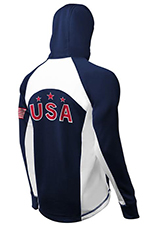Title: Captain’s Henley jacket
General Information about Item:
- Genre: Material, Customary Folklore
- Subgenre: folk costume, traditions
- Language: English
- Country of origin: USA
Informant Data: Grant McArtor ’19 is a 21-year-old caucasian male student from Spartenburg, South Carolina in the United States. He was originally born in Pittsburg, Pennsylvania. He has been rowing light-weight crew for five years (since junior year of high school) and has rowed on Dartmouth’s D150 varsity team since his freshman year.
Contextual Data:
Social Context: As with any bequest, this item is traditionally passed down from graduating seniors to underclassmen on the rowing team who are deemed most fit to receive the object. This exchange happens annually in the spring after the competition season has come to a close. The event involves the whole team and requires presence for several hours, as each senior may give away several bequests, each with a description of the significance of the item and why it goes to the recipient underclassmen. During the process, teammates must wait until they either bequeath or are bequeathed an item. It is a spectacle for the team and is often humorous and emotional. Underclassmen express gratitude through words and little physical contact as to expedite the process. It has been compared to receiving a Christmas present. This bequest is passed down from current captain to future captain.
Cultural Context: Bequests are handed down through a line of rowers throughout the years. This line is connected through a common trait (e.g., captainship, knowledge of statistics, heavy weight). The bequest links generations, creating team cohesiveness through history. The bequest indicates a unique importance and role in the team and generally shows that the recipient upholds the values of the team. Rowers wear bequests to exhibit that they are deserving of the honor bestowed upon them.
Item: This bequest is the Captain’s Henley jacket. It is green with white trim and has a D150 patch on the breast pocket. It is from the Henley Royal Regatta, a rowing event held annually on the River Thames in England. The jacket is a high honor on the team, only given to the rising captain of the next year.
Associated media:
Informant’s Comments: He expressed that bequests are not limited to clothing items, but clothing is a common way to exhibit membership to the team. He said that the Henley jacket is one of the highest honors in terms of bequests.
Collector’s Comments:
- The informant recently left the team.
- The receipt of this bequest in particular resembles the marking or transfiguration of the hero in Propp’s list of fairy tale functions.
- The receipt of the bequest resembles a rite of passage. Before the ceremony, the rower is a freshman member. He is then separated from his fellow freshmen as he is called up by the senior. During the transition phase, he receives the bequest and shows gratitude to the senior. He is then incorporated back into the team as a new version (labeled by the bequest) of his old self.
Collector’s Name: Sam Gochman
Tags/Keywords: D150, Dartmouth Light-Weight Rowing, Bequests, Henley



